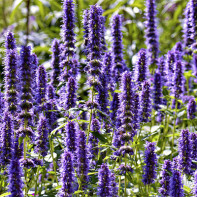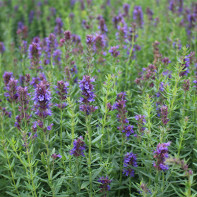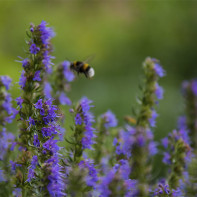Hyssop: medicinal properties and contraindications
Medicinal herbs are often harvested in the wild. But already at the time of Peter I, a medicinal garden was laid, which eventually grew into a luxurious botanical garden. The beginning took root, and almost every mistress in a personal or summer cottage plot has a small, and sometimes quite voluminous bed, where spicy, fragrant and medicinal herbs grow. Often they perform at the same time a decorative function, such as hyssop. It grows beautifully on almost any soil, and if the minimum requirements for watering and care are met, it gives a good harvest, supplying the garden owners with excellent medicinal raw materials for the treatment of many diseases.
- How it looks and where it grows
- Views
- Collection and storage
- Chemical composition
- The healing properties of hyssop herb
- For women
- For men
- For children
- Hyssop herb in medicine
- Types of healing compounds with hyssop
- The juice
- Decoction
- Infusion
- Tea
- Alcohol tincture
- Hyssop oil: properties and applications
- The properties
- Application
- Use in cosmetology
- Hyssop in cooking
- Feta stuffed pepper
- Vitamin Salad
- Blueberry pie
- How to grow hyssop from seeds
- Contraindications
How it looks and where it grows
In the wild, hyssop is found in Europe and Asia. It continues to grow on the hillsides, choosing rocky, dry patches. But now rarely is anyone hunting for a medicinal plant in its natural conditions, preferring to grow a fragrant and elegant shrub at home. It began to be cultivated in ancient times. The medicinal properties of hyssop were well known in ancient Greece, using in medicine, cooking, cosmetology.
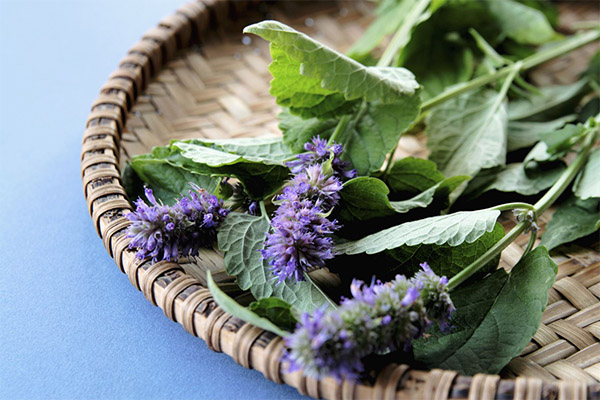
The plant has several names, and depending on the region it is called bee grass or blue hypericum. Indeed, there is some external similarity, but experienced herbalists will never confuse these plants. For a wide range of applications, it is called a summer cottage doctor and they try to plant it in the corner of the site, all the more so since it looks really elegant.
A low shrub reaches a height of 65–70 cm, numerous stems depart from the powerful root, covered with strong bark at the base and gradually thinning to the crown. The leaves are arranged in tiers, elongated, narrow, with tips slightly bent inward. Flowering begins in July and lasts until September. The color of the flowers is mostly blue, less often a lilac or pink hue. Sometimes you can see white flowers, but they are considered an exception to the rule. The bush belongs to perennials, tolerates drought and harsh winters, revealing fragrant leaves towards the sun every spring. From the leaves and flowers comes a strong spicy aroma that scares away pests from the garden and attracts bees. Often it is planted around the apiary, collecting healing fragrant honey.
Views
They are few, only 3 varieties are known.
- Narrow-leaved or medicinal hyssop is most often used for the preparation of decoctions, infusions and tea. Its flowers are collected in small inflorescences of 8-10 pieces. It is harvested as necessary throughout the summer, starting from the opening of the first buds to the end of flowering, cutting off the upper half of the stems along with leaves and flowers. Hyssop planted in the garden lives perfectly in one place for up to 10 years, without requiring a transplant.
- Cretaceous is named for its addiction to soils with a high content of chalk. Belongs to rare species, is listed in the Red Book. It differs from the ordinary in more miniature sizes and a lower level of decorativeness. The smell is sharp with a balsamic hue, the inflorescences have a cornflower hue.
- Anise is very beautiful in appearance, smells of anise. To enhance the smell, just gently rub the leaf. It is sometimes called licorice mint for a specific flavor. It can be easily distinguished from other species by purple spots on the leaves and the height of the stems, reaching under favorable conditions 100 cm.Blue flowers are gathered in terry dense inflorescences, they open gradually, starting from the lower tier, and the bush retains a spectacular appearance until autumn. In cooking, delicate buds and already blossoming flowers are used, which are added to salads, giving them a unique spicy flavor.
It is worth considering: species can be dusted when co-grown, so they are best planted in different segments of the garden.
Collection and storage
For all varieties, the timing of collection and the principle of harvesting are the same. Much depends on the purpose of use. For fresh salads, leaves and flowers are torn off manually as needed. For use in broths, it is better to start harvesting at the very beginning of flowering. If it is planned to store the raw materials in crushed form, then it is better to wait for the height of flowering when the plant becomes most fragrant.
Separately, choosing parts of hyssop is not necessary. Simply cut the stems and tie them into a broom, hang them in a shady, well-ventilated place.
Important: Hyssop contains many essential oils. From exposure to direct sunlight during drying and storage, they disappear, several times reducing the healing properties of the plant.
Finished raw materials are stored in linen bags. When grinding, it is more convenient to place the grass in containers with a tightly ground lid. The dried plant retains its original properties for 2 years.
Chemical composition
In small narrow leaves and bright inflorescences there are many useful elements. Among them:
- tannins;
- flavonoids;
- organic acids;
- bitterness;
- essential oils;
- glycosides;
- resins;
- gum;
- vitamin C;
- alcohols;
- camphene;
- cymol;
- cineol.
The composition includes biologically active substances that allow the plant to be used as a medicine.
The healing properties of hyssop herb
Blue St. John's wort received the title of cottage healer deservedly. It is used in many folk recipes as an anti-inflammatory, wound healing, disinfectant. Use it to get rid of intestinal parasites, brewing as tea. The smell resembles thyme and mint, has a calming effect, relieves excessive irritation, and prevents the development of depressive states. A powerful therapeutic effect is achieved in the prevention and treatment of disorders of the central nervous system. It is important that with a pronounced sedative effect, decoctions from hyssop do not cause drowsiness or inhibition of reactions. There is an increase in memory, attention, and ability to concentrate.
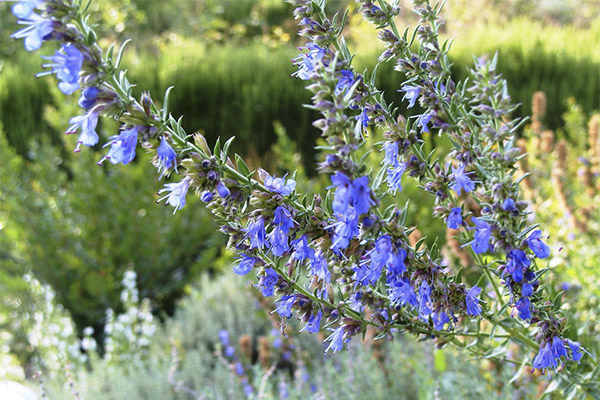
For people suffering from frequent respiratory diseases, bronchitis, hyssop is useful for its antispasmodic effect. It dilates blood vessels, eliminates cough, facilitates breathing, has an expectorant effect. Essential oils during inhalation relieve inflammation, inhibit the development of pathogenic bacteria.
During the course of the use of fees based on hyssop, the secretory function of the gastrointestinal tract is established, fermentation of juices is enhanced, a mild laxative effect is manifested, bile circulation is established.
The ability of a plant to accelerate regeneration, stop the reproduction of staphylococcal infection, prevent inflammation of wounds, and eliminate abscesses is very much appreciated.
Decoctions, infusions and compresses based on hyssop recommend:
- with diseases of the respiratory system, including asthma and tuberculosis;
- fungal skin lesions;
- increased emotional excitability;
- hyperhidrosis;
- rheumatism;
- diseases of the genitourinary system;
- frequent colds.
Hyssop is perfectly combined with other plant components, honey, licorice root, berries and raspberry leaves.
For women
Decoctions of grass relieve the severity of PMS and menopausal syndrome, improve skin condition, inhibit age-related changes. Extracts, extracts and essential oil have found their application in cosmetology.
For men
The plant belongs to natural aphrodisiacs. The tool is prepared from flowers and white wine, where at 1 tbsp. a spoonful of plant material accounts for 1 liter of drink. The infusion is kept for 10 days in a dark, cool place. To fully dissolve the essential oils, the container is shaken daily.Take 50 drops 2-3 hours before bedtime.
For children
General recommendations for use, the plant is effective in respiratory diseases and inflammatory processes. Children under 12 years of age should not use blue St. John's wort, except in cases where the predicted benefit exceeds the possible harm.
Hyssop herb in medicine
The plant is on the list of officially recognized, its properties are well studied. In folk recipes, it is used to urgently relieve a hangover syndrome, eliminates tremors, nausea, and returns the ability to think quickly and adequately respond to external stimuli. Decoctions are part of complex therapy during rehabilitation after operations, injuries, large blood loss.
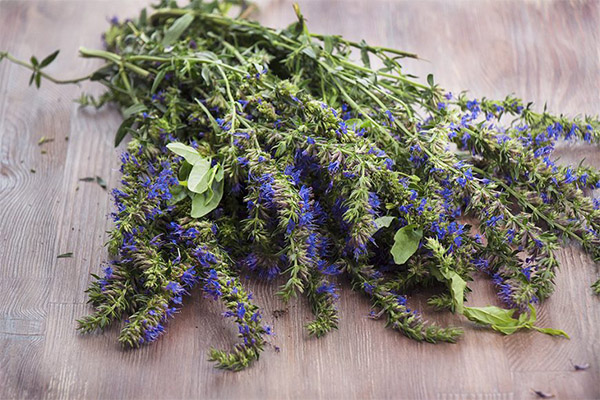
The use of the extract in strict dosages is practiced to prevent the development of senile dementia. With a violation of the functions of the gastrointestinal tract, flatulence, dysbiosis, decoctions are able to restore the beneficial microflora and activate intestinal motility. For women over 40, it is useful to include herbal teas with hyssop to reduce the intensity of menopausal symptoms.
Recipes
- From cough hyssop is brewed in its pure form and with the addition of other components. Most often, 1 liter of boiling water and 1.5 kg of sugar are taken per 100 g of dry raw material. First, the grass is poured with boiling water for 30 minutes and covered with a towel. Then filter, add sugar and simmer over low heat until syrup. In the finished product is mixed with 1 tbsp. a spoonful of honey. Take 4-5 times a day for 1 tbsp. spoon means for liquefaction of sputum, relieve cramps and facilitate breathing. With asthma, a decoction is prepared without sugar and honey. The proportions and the reception regimen are the same.
- With bronchitis, regular elimination of bronchospasm leading to shortness of breath, shortness of breath, and constant coughing is very important. To prepare the product, you need 2 teaspoons of hyssop per 200 ml of boiling water. The grass is insisted for 30 minutes, taken 3 times a day, 150-200 ml. It is best to cook a new broth every time shortly before the reception.
- For allergies, blue hypericum is used in the form of infusion, observing the proportion of 2 teaspoons of flowers per 1 cup of boiling water. It is more convenient to make the mixture in a thermos, keeping it there for 2-3 hours. Reception is half a glass 3 times a day.
- With menopause, hyssop is also effective in relieving irritability, insomnia, feelings of unmotivated fear, anxiety. It reduces the frequency and intensity of hot flashes, relieves headaches, and improves immunity. A decoction of 5 g of raw material per 250 ml of boiling water is used. For a stable effect, the drug is taken in a course, 3 times a day, 120 ml in a warm form 30 minutes before a meal. The duration of treatment is 2 weeks. Then you need to take a break for 30 days and the course can be repeated.
- To eliminate chronic fatigue syndrome and improve appetite, a decoction is also used. It is prepared from 5 g of fresh herbs and 400 ml of boiling water, keeping in a water bath for 15 minutes. Drink instead of regular tea half an hour before meals.
Types of healing compounds with hyssop
Blue St. John's wort is used in the form of decoctions, syrups, water and alcohol infusions, extracts and extracts.
The juice
It is made from fresh raw materials. The grass is passed through a meat grinder, the pulp is squeezed through gauze or a layer of cotton cloth. Applied to eliminate a hangover, 40 drops, mixed in a glass of water. To reduce perspiration, the juice is diluted with water 1: 1 and wiped axillary hollows, feet and palms.
Decoction
Used most often with external injuries. The ratio of grass and water - 1 tbsp. spoon per 100 ml. The raw material is poured with boiling water, kept for 30 minutes in a water bath, then cooled to a warm state and filtered. Lotions, compresses are made of it, washing is performed for cuts, wounds, inflammations, joint pains.
Infusion
It is stored for no more than 24 hours, so it is recommended that fresh preparations be prepared before each use. Used for problems with the gastrointestinal tract, as a diuretic, strengthening agent for weakness of the heart muscle. 20 g of dried flowers are poured into 200 ml of boiling water, kept for half an hour, taken 2 times a day.
Tea
Brew before use at the rate of 1 hour.spoon in a glass of boiling water, stand for 5 minutes. You can add raspberries, honey, lemon. Accepted as a restorative, tonic, antimicrobial agent during the off-season. Recommended 1-2 cups per day.
Alcohol tincture
Its advantage is the long shelf life. A half-liter jar is filled with chopped grass and poured with vodka almost to the neck. The container is tightly closed with a lid and cleaned in a dark place for 7 days. The recommended dosage is 30 drops up to 5-6 times a day. Tincture can not be used by pregnant, lactating, people with epilepsy or alcohol dependence, children under 12 years of age.
Hyssop oil: properties and applications
The essential components of blue hypericum are very much appreciated. The cost of the finished product is high, but the benefit justifies the money spent. You can buy oil in pharmacies and most often only on order. Production is very expensive for raw materials, in relation to the initial mass, the oil yield is only 0.2%.
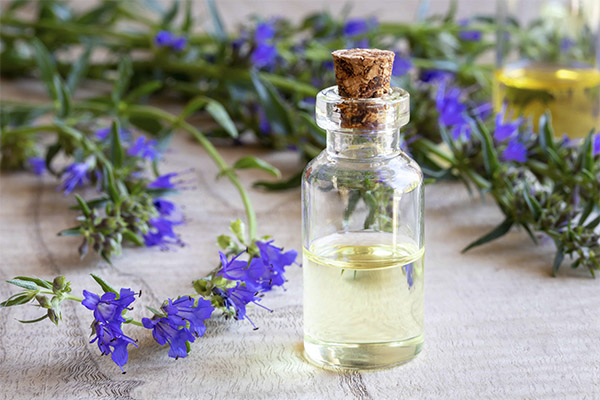
The properties
The tool is used as an antiviral, tonic, antimicrobial. It is able to increase physical stamina, stabilize the emotional state, improves digestion, and stops inflammatory processes. It also has an astringent, antirheumatic, antispasmodic, antipyretic, anthelmintic, expectorant effect.
Application
Oil is used externally for inflammation, skin and joint diseases. Lotions and compresses are effective for bruises, bruises, superficial skin lesions, acne, dermatitis. Essential oil is included in aromatherapy mixtures, massage compositions, added to the bath, effective for colds as an inhalation. The product is combined with sage, lemon balm, citrus, geranium, rosemary.
Important: The use of essential oils in high concentrations is prohibited.
Use in cosmetology
The oil component, extracts and plant extracts are introduced into the composition of soaps, shampoos, creams and lotions. Decoctions and infusions for washing are indicated for acne, a pronounced vascular pattern, dermatitis. Regular use improves complexion, reduces fine facial wrinkles, accelerates regeneration in case of microdamages.
Hyssop in cooking
The spicy taste and bright rich aroma became the reason for the introduction of fresh leaves and flowers into salads, sauces, seasonings. It is part of complex seasonings for meat and fish dishes, pastes, minced meat, sausages. In some recipes, it is recommended to add it to bean soup, stuffed eggs, sandwich mass, pies and dumplings, meatballs and stews.
Saturated and tart hyssop is used to create world famous drinks such as absinthe, Benedictine and Chartreuse liquors. Fresh and dried leaves are placed in berry tinctures on alcohol and moonshine to enrich the taste, eliminate the smell of fusel oils.
Among the recipes there are very original and easy-to-cook dishes for every day or for special occasions.
Feta stuffed pepper
For cooking you will need:
- red bell pepper;
- feta;
- vegetable oil;
- a mixture of spices, which includes oregano, thyme, sesame, hyssop 3-4 g;
- salt.
Pepper thoroughly washed, take out the middle along with the seeds. Then the billets are baked in the oven until softened and cut in half. A little feta is placed in each half, then the workpiece is folded in half or wrapped in a tube. Then the halves are gently laid out on a baking sheet, sprinkled with a mixture of spices, salt and returned to the oven for another 10 minutes.
Vitamin Salad
The dish is designed for lovers of unusual tastes, as the composition combines sliced watermelon, cream cheese, leek.The mixture is poured with a sauce of cream, black pepper, anise, fresh leaves and inflorescences of hyssop, chopped herbs with a drop of apple cider vinegar.
Blueberry pie
Tender shortcrust pastry is the basis on which the filling of berries is laid. They are mixed with a part of sugar and fresh finely chopped hyssop leaves, giving the mixture a slight spicy astringency and indescribable aroma. Bake for half an hour at a temperature of 180 degrees. Dessert is highly appreciated by adults and children, easy to prepare, takes little time and does not require special culinary skills. For the basics, you can pre-purchase a frozen piece of shortcrust pastry in the store.
There are optimal dosages of spices for different dishes. About 0.5 g of dry grass is added to soups. For garnishes, meat and fish dishes, desserts and marinades, 0.3 g will be enough. Hyssop is harmoniously combined with marjoram, fennel, basil, mint, parsley, dill.
How to grow hyssop from seeds
The plant is unpretentious to conditions, and since it is a perennial, it is most often planted with seeds immediately in a permanent place. To do this, choose a small hill in a dry sunny place. In nature, he prefers the stony slopes of the hills and does not tolerate nearby groundwater. In landscape design, it is used in mixed flower gardens, in the design of alpine hills, as borders. Therefore, it is worth looking at the design options for the site and combine business with pleasure.
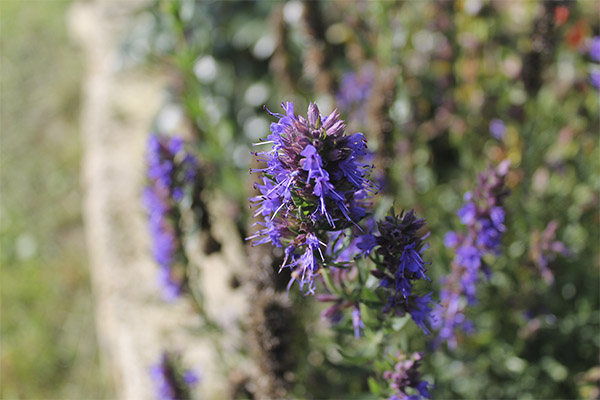
Planting time is in late April and early May, after the cessation of night frost. Seeds are mixed with sand and distributed over small grooves. The embedment depth should not exceed 0.5–1 cm, otherwise the emergence time will be delayed by 1-2 weeks. If hyssop is sown in the winter, then the first leaves will appear as soon as the heat level is stably kept at +5 degrees.
No special care is required. It is only worth remembering that it is better to under-fill the bush than to pour it. Watering is carried out 3-4 times per season. Special feeding is also not necessary. The ancestors of this plant did well without additional fertilizers, which was fully transmitted to the cultivated species. It is enough to pour them with ash solution, sometimes add nitrogen or complex preparations in the spring at a minimum concentration. If you give them too much, then the bush will begin to form excess green mass to the detriment of flowering.
Trimming is not worth neglecting. It is held during the summer for the preparation of medicinal raw materials and in the fall for better wintering. It is more convenient to form rounded outlines of the bush. Then next year he will quickly grow.
Sometimes gardeners try to grow blue St. John's wort in a seedling way. Then the landing dates move to the end of March. Sprouts make their way after 1–1.5 weeks, stretch out quickly and require transplanting to a permanent place, so they should not be sown in cassettes or peat pots too early.
In one place, the plant successfully develops for about 5–7 years, then the soil becomes depleted, the bush becomes too large, it needs a transplant. At the same time, you need to divide the plant into several parts for its rejuvenation. Many gardeners try to plant several bushes near the porch, under the windows or in the recreation area. The secret is simple - the smell is so specific to insects that even mosquitoes and flies cannot withstand it, flying around the bushes of the tenth road.
Contraindications
The plant has special properties that impose certain restrictions on its use in food or as a medicine. Decoctions and infusions from hyssop should not be given to pregnant women, it can provoke a miscarriage. Those suffering from epileptic seizures, hypertensive patients will also have to choose another plant.
In especially sensitive people, blue hypericum in high concentration causes allergies.With frequent convulsions, neuropathy, kidney and nervous diseases, accompanied by loss of consciousness, hyssop can cause a relapse.
Before using decoctions and tinctures based on hyssop, it is advisable to consult a doctor. For more than 30 days, a course of treatment is not carried out. Then, a break is taken for a month.
Fragrant and spectacular hyssop will be a wonderful decoration of the garden and a natural first-aid kit, which will always be at hand.
«Important: all information on the site is provided exclusively in fact-finding purposes. Before applying any recommendations, consult with a profile specialist. Neither the editors nor the authors are liable for any possible harm caused materials. "


